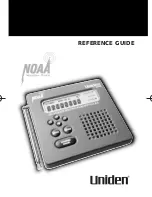
Caution!
Risk of injury:
•
Keep these instruments and the batteries out of the reach of children.
•
Batteries must not be thrown into a fire, short-circuited, taken apart or recharged. Risk of explosion!
•
Batteries contain harmful acids. Low batteries should be changed as soon as possible to prevent
damage
caused by leaking.
•
Never use a combination of old and new batteries together, nor batteries of different types.
•
Wear chemical-resistant protective gloves and safety glasses when handling leaking batteries.
Important information on product safety!
•
Do not place your device near extreme temperatures, vibrations or shocks.
•
Protect it from moisture.
•
The outdoor transmitter is protected against splash water, but is not watertight. Choose a shady and
dry
position for the outdoor transmitter.
!
!
•
Place both instruments on a desk with a distance of approximately 1.5 meter. Avoid getting close to
possible interference sources (Electronic devices and radio installations).
•
Remove the protective foil from the display of the
receiver
.
•
Remove
the
battery
cover
and
insert two new batteries 1,5V AAA,polarity
as
illustrated,Close
the
battery
compartment
again
.
•
The device will alert you with a beep and all LCD segments will be displayed for a short moment.
•
The
default
:
T
IME:
2015
-
1-1
, 0:00;
Week
langauge
:
ENG;
ALARM: 7:00, OFF ; Hour system: 24hr;
Temperature unit:
°
C
6.2 Inserting the batteries in the outdoor transmitter
•
Open the screwed battery compartment of the outdoor transmitter.
•
The slide switch for channel selection is at position 1 (default).
•
Insert two new batteries 1,5 V AAA, polarity as illustrated.
•
Close the battery compartment again.
6.1 Inserting the batteries in the receiver
6. Getting started
•
The outdoor values of the outdoor transmitter will be transmitted to the
receiver
. The displays of the
out
door values are flashing "--.-".
•
On the display of the
receiver
appear the channel number, the outdoor humidity and the outdoor temp-
er
ature in
°
C
(default).
•
If the reception of the outdoor values fails within three minutes, "- -"appears on the display. Check
t
he
batteries of the transmitter and try it again. Check if there is any source of interference.
•
You can also start the outdoor transmitter search manually later on (for example when the outdoor
transmitter
i
s lost or the batteries are changed).
•
Hold the
SEAR
CH button on the
receiver
for three seconds,"---"appears on the display.
•
Press the TX button in the battery compartment of the outdoor transmitter.
•
The device will alert you with a beep and the
receiver
receives the values from the outdoor transmitter.
•
After successful installation close the battery compartment of the outdoor transmitter carefully.
6.2.1 Reception of the outdoor values
6.3 Reception of the DCF frequency signal
•
After the reception of the outdoor values, the device will now scan the DCF frequency signal and
the DCF symbol will be flashing on the display.
•
To avoid interference, the
other
buttons
will
no
function
during the reception of the radio controlled
clock.
-3-

























